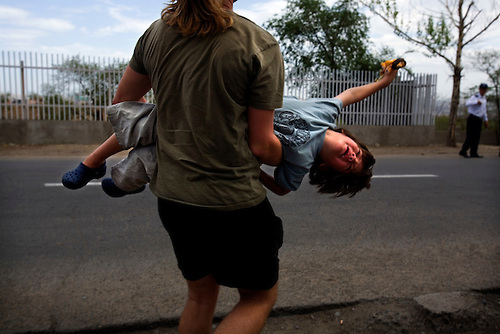“You’re KILLING me, I can’t BREATHE, I’m HOT, let me go! You’re hurting me. What kind of MOTHER hurts her own SON.”
I look down and check. My hands are so loosely around his 7 year old wrists. Admittedly, I was holding him pretty tight a few minutes ago but now it feels like he just needs an impression of being contained to thrash against.
“I’m right here Angel, I’m not trying to hurt you, I’m going to let you go as soon as you can stop hitting and breaking. I see you breathing. Yes, you’re getting hot.”
This routine on repeat was how we lived our lives for several months when my son was suicidal, wetting himself, had many explosive, aggressive meltdowns a day, was so anxious he couldn’t fall asleep and woke several times in the night. He would roll out of bed screaming some mornings, he’d hurt or throw his sister around if we got there too late or try to bite/slap/wet himself or headbutt the floor when he got distressed.
Some of us have these intense kids. So beyond just keeping everyone safe, what measures can we apply to actually remedy this level of distress in the family?
I’ve wanted to write something on helping children with anxiety/aggression/OCD/self-harming type behaviours using these therapeutic, trauma informed parenting tools from Hand in Hand and based on my experience as a mother, because I know they are many others out there enduring this level of stress in family life. And none of us tend to talk about it too much.
Some of our kids show us that they are really hurting through more extreme behaviours. These can include being apparently cruel or controlling, self-harming, expressing suicidal thoughts, intense verbal or physical aggression, obsessive thoughts or behaviours, often accompanied by a level of clinginess or intense need for attention. Though these behaviours can be worrying for us as parents they are really just a louder signal for connection than more regular off track behaviour and are not necessarily the sign of pathology that we tend to read into the situation. Many children display fear driven behaviours and our intense kids just have a bigger chunk of fear that went into their system that will require a greater investment of connection and listening to lift it out.
Holding the reality
One thing that is important to remember when dealing with chronic fear is that it can cause distorted thinking and a skewed perspective on reality. When we have been immersed in relating to our child’s fear for some years, we too can buy into their skewed perspective. When our children are anxious, everything can look more scary, more doubtful, more hostile than it really is. It’s up to us to maintain a balanced view of reality. We need to make sure we are not pandering, walking on eggshells or tiptoeing around this fear. We want to be able to call it out and set limits on unhealthy thinking. Simple observations such as “I see that there are no ants” are adequate. You may also need to set limits that ground your child in reality such as “I can’t let you wash your hands again, I saw that you didn’t touch the bin”.
Personifying the fear
It can be helpful to talk about the fear as an entity in itself. A fellow Instructor’s girls say things like “that was just my fear talking” because she models that way of thinking herself. If she ever gets rigid or worried in her parenting, she will apologise afterwards, saying that her fear had got hold of her thinking. When you personify fear you can also draw pictures of it and stamp on them or ask your child to imagine pushing the fear away.
Setting limits with the fear
You can also set limits with the fear “I know you feel like you want to go, but your fear is telling you it’s scary and I’m going to make sure you still get to go.” You can even talk to your child about not letting their fear win. “I know your fear makes you feel like it’s impossible to go over and introduce yourself, but I don’t want your fear to win by stopping you doing something you want to do, so I’m not going to go over for you. I’m right here making sure you go over yourself”.
The difference between this approach and the more traditional chivvying-along-and-minimising approach (“Go on, you’re FINE, don’t be silly”) is that when we set a limit we expect to listen to the feelings and protesting that will come up. We say “Yes, it feels too embarrassing, you don’t want to go”. And then we hold the limit saying “I know you can do this, I’m going to make sure you do”, all the time listening to the upset and offering our warmth and presence. We worry about upsetting our children when they are tightly wound about particular issues. It can be helpful to see it as a short-term increase in anxiety for a long-term decrease in anxiety.
Listen to the fear
Often when we set limits or make simple observations that counter the fear, our child will tell us all the reasons why this is scary. This is something we want to encourage. When we move in warmly and Staylisten (stay close and allow the upset feelings to pour out), saying things like “say more about that” or “what’s the worst thing you can imagine happening here”, they get to release the worry rather than hold it in tight. They may need to catastrophize and get even more anxious. When we can stay close and remind them of their safety, they get to make use of the body’s natural mechanism for getting rid of stress; the emotional release of tension through crying/laughter/trembling/raging.
My son was getting anxious at bedtime saying he was having dark thoughts. When I encouraged him to say more, he was frightened that saying it out loud would make it happen. I insisted that he could say it all and it would certainly not make it happen. He blurted out that he was frightened his dad would die, had a little cry and then said “actually mum, you’re right, I do feel a bit better now”.
Physicality
For a lot of children battling with fear, physical activity or play of some kind might be essential. In rough play with us, they get to come up against us physically, which feels really good and reminds the limbic system (emotional centre of the brain) that we really are there. It may be of benefit for fearful children to develop a practice that allows them to become physically adept, such as sports, martial arts, climbing or surfing. As they notice their own physical prowess, it counters the feelings of powerless or inadequacy and helps to facilitate the release of the underlying hurt.
Playlistening
Getting laughter going can be a great release for fear. Likewise, any silliness such as food fights, or general nonsense-making to get a giggle, is always worth the investment. Sometimes it can be a relief for our kids when we engage in dark humour with them. When my boy has been flooded with heavy thoughts, he laughs a lot when I get darkly surreal with him. He would say something like “I’m going to stand in the road and get hit by lorries” and I’d respond by fantasizing about all the different comical ways I’d ‘like’ to die, while he giggled and felt ‘felt’ by me. For example, you might use a stuffed toy to represent someone they are upset with and let them do horrific things to them, while you make the screams and moans and egg them on.
Parents worry that allowing children full expression of fears or to play out dark urges will encourage them to think or act this way even more. The irony is that when we try to suppress these feelings, they persist because they don’t have a way out. They body’s innate recovery system from hurt or trauma is through the use of its emotional release capacity. It’s through expression that this accumulation of tension leaves the body.
Supporting ourselves
Working with children’s fear can bring up lots of feelings in us and we can only really be available to support them when we have an outlet for these. If we are alarmed by what our child expresses or if their anxiety kicks ours off, we can’t offer the safety and resource they need to be able to use the emotional release process. When we can take our concerns to another adult and process them away from our child, we can return with a lot more emotional availability for them. We call it Listening Partnerships when two parents exchange time to listen to one another to release feelings. Often anxiety tends to run in families. It can help us help our children when we keep working on our own fears and explore the history of where this started for us.
It’s not going to happen overnight, but we truly can support the release of fear that manifests in some of these stronger behaviours and expect to see them shift. The boy I described above, I would now describe as mildly anxious and sometimes lacking in self confidence. His aggressive and distressed behaviours are no longer present. Over time, helping this accumulation of feelings disperse will lead to a more relaxed, confident child.
If you found this article helpful you may wish to see this one I wrote for JUNO Magazine on fear.
And if you need support to unravel a fear based issue in your family, one-on-one consultations, where I can walk you through the process, might be the best option.



Hello, I’ve just found your wonderful blog and something in the article above stood out for me.
You said that sometimes your little boy would wake up screaming.
For roughly the last 6 months my little boy often wakes up crying. Sometimes he has a little cuddle and jumps straight into my bed and back to sleep. Other times he says his legs hurt (I’m thinking growing pains as he has a mild problem with his feet and legs) but the most concerning thing is that sometimes he comes into my room sobbing or I meet him on the landing as I usually hear him and he goes in to full tantrum mode screaming, not being able to speak at some points, then screaming for his dad to go away then cries calling for him again. The slightest thing seems to send him into a meltdown. All this happens in the middle of the night. It’s even worse if his dad tried to comfort him, he usually prefers me. Does this sound like he’s working through things that have happened or built up overtime? I’d expect that if it was happening in the daytime but it seems strange to have these outbursts in the middle of the night?
Hey Becky,
Thanks for reaching out. It can be really alarming when our kids get night terrors. Yes, it sounds like he is wisely trying to offload some stored up feelings during the night. Obviously it can be harder to listen at night when you’re missing sleep, so you might want to engineer opportunities for more listening during the day. You can start by increasing the connection through offering Special Time and then set limits around things you might usually let go, so that he has something to push against to get the feelings up. When you can lift out chunks of fear through daytime Staylistening, you’ll see less crying at night. Also check out the article on here on fear. Hope that helps x